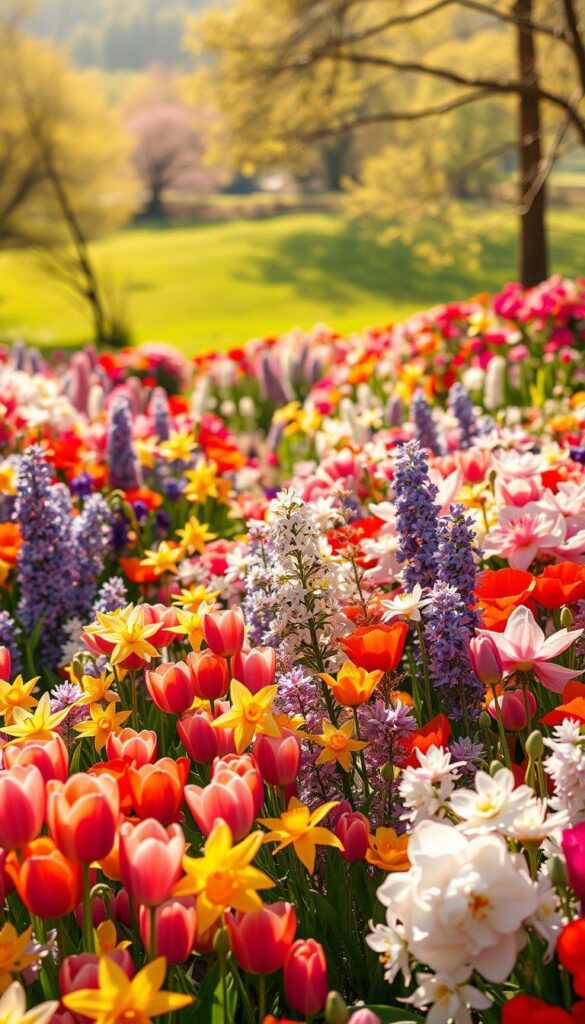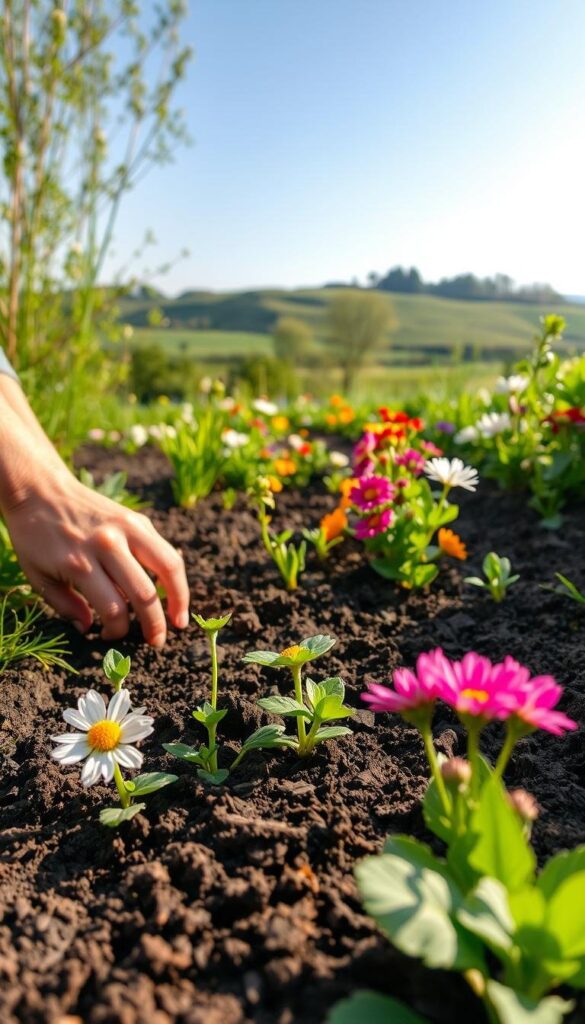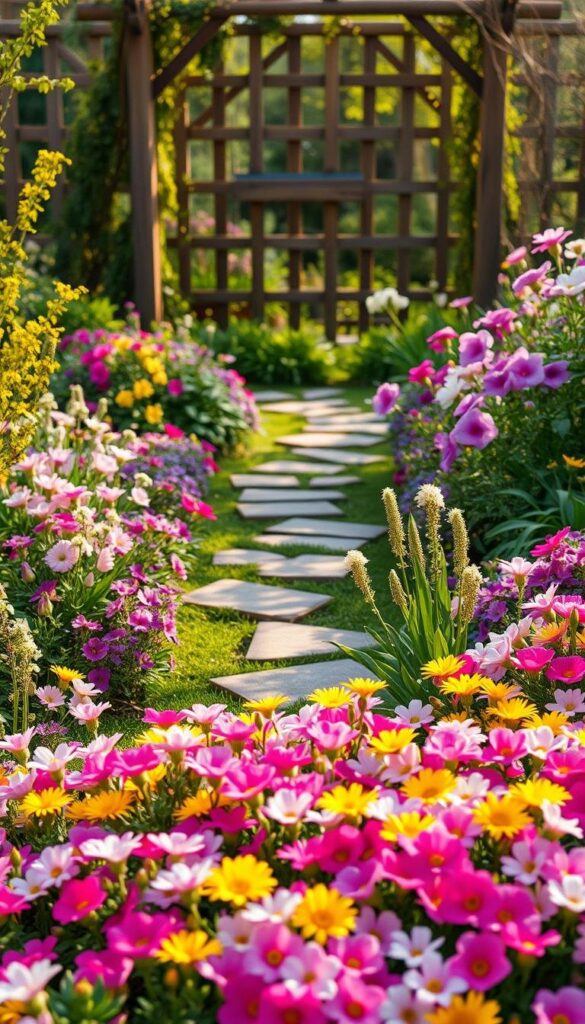This post may contain affiliate links. If you click and buy, we may earn a small commission at no extra cost to you. Learn more.
Spring Flowers Garden turn outdoor areas into lively spots of color and life after winter. Whether you’re experienced or new to gardening, these flowers offer inspiration to brighten any yard. This guide will help you pick, plant, and care for flowers that make your yard joyful.
Find out how to create a vibrant garden with simple steps. Learn about popular flowers like tulips, daffodils, and hyacinths, and the care they need. Let’s make your space a spring wonderland full of beauty and life.
Contents
- 1 The Importance of Spring Flowers in Your Garden
- 2 Choosing the Right Location for Your Spring Garden
- 3 Top Spring Flower Varieties for Your Garden
- 4 Planting Spring Flowers: A Step-by-Step Guide
- 5 How to Care for Your Spring Flowers
- 6 Seasonal Pest Management for Garden Flowers
- 7 Designing Your Ideal Spring Flower Garden
- 8 The Role of Native Plants in Your Spring Garden
- 9 Extending the Bloom Period of Spring Flowers
- 10 Spring Flower Arrangements for Your Home
- 11 Preparing Your Garden for Summer
- 12 Celebrating Spring with Garden Events
The Importance of Spring Flowers in Your Garden
Spring Flowers Garden turns outdoor areas into lively spots and personal retreats. These blooms end winter, bringing more than just beauty. They lift our mood, increase home value, and help local wildlife. Let’s dive into their bigger impact.

Benefits of Spring Flowers
Early flowers like tulips and crocus boost our mood. Research shows their colors and smells lower stress, making outdoor spaces peaceful. Homes with Spring Flowers Garden see a 5-15% boost in appeal.
Also, growing these plants gives gardeners a feeling of accomplishment. Flowers bloom after months of hard work.
Impact on Pollinators
Seasonal blooms are a lifeline for bees and butterflies when food is scarce. Flowers like hyacinths and daffodils offer nectar early, helping pollinators survive. A well-thought-out Spring Flowers Garden supports local bee populations.
Choosing pollinator-friendly plants makes your garden eco-friendly. It becomes a haven for nature.
Choosing the Right Location for Your Spring Garden
Smart garden design starts with knowing your space. Whether it’s a big bed or a small spot for flowers, your choices matter. First, look at your yard’s light and soil.

Sunlight Requirements
Flowers need the right light to grow. Here’s how to figure out your garden’s sun:
- Full sun: 6+ hours of direct light daily. Perfect for tulips and daffodils.
- Partial shade: 3-6 hours. Go for plants like violets or bleeding hearts here.
- Full shade: Less than 3 hours. Ferns or hostas are best in this spot.
A well-planned garden considers light like a puzzle—each piece has its perfect spot.
Soil Preparation
Good soil means strong roots. Here’s how to make your soil rich:
- Test soil pH with a home kit. Most spring flowers like 6.0-7.0 pH.
- Use compost or peat moss to add nutrients and improve drainage.
- Loosen compacted soil with a garden fork to 12 inches deep.
With the right sunlight and soil, your garden will bloom beautifully. Whether you’re redoing a bed or starting from scratch, these tips help your garden thrive.
Top Spring Flower Varieties for Your Garden
Make your Spring Flowers Garden pop with these timeless blooms. They’re perfect for borders or flower bed ideas. These three varieties bring color and charm to your garden.

Tulips: A Classic Choice
Tulips love full sun and come in over 100 varieties. You can choose from bright red Darwin hybrids to delicate parrot tulips. Their cup-shaped petals add elegance.
Pair them with low-growing pansies for a layered look. Plant bulbs 6–8 inches deep for strong roots.
Daffodils: Bright and Cheerful
Daffodils are deer-resistant and bloom for a long time. They grow well in lawns or woodland edges. Plant clusters of yellow ‘King Alfred’ or orange ‘Salome’ for a bold look.
Their toxicity keeps pests away, making them easy to care for.
Hyacinths: Fragrant and Colorful
Hyacinths bloom early and are fragrant. They come in colors from deep purple to soft pink. Place them near walkways to enjoy their scent.
Space bulbs 4 inches apart to avoid overcrowding. Combine with dwarf iris for vertical interest in flower beds.
Planting Spring Flowers: A Step-by-Step Guide
Ready to start your garden? Let’s get into the flower planting tips for a stunning spring garden. Follow these steps to make your garden shine from the first sprout to full bloom.
Timing Your Planting
Timing is key for bulbs. Plant tulips and daffodils in fall, 6–8 weeks before the ground freezes in USDA zones 3–7. In warmer zones 8–10, plant in early spring. Check local frost dates at USDA Plant Hardiness Zone Map. For a longer bloom show, stagger planting times or mix early, mid, and late-season varieties.

Spacing and Arrangement Tips
- Depth first: Plant bulbs 2–3 times as deep as their height (e.g., 5-inch tulip bulbs go 10–15 inches deep).
- Space smartly: Leave 3–6 inches between bulbs. Crowded plantings lead to weak stems.
- Design with flow: Create natural drifts by scattering bulbs in clusters. For formal gardens, grid patterns work best.
Layer smaller flowers like crocus under taller hyacinths for dynamic displays. Group same species together to simplify care.
Patience and precision now pay off in spring’s vibrant reward. Adjust steps to your region’s climate, and watch your efforts bloom into beauty.
How to Care for Your Spring Flowers
Keeping a Spring Flowers Garden alive needs regular care. The right amount of water and food helps seasonal blooms come back strong every year. These steps help your flowers stay healthy as they grow.
Watering Guidelines
How you water is very important when your plants are growing fast. Here’s what to do:
- Check soil moisture by touching 1-2 inches deep before watering.
- Water deeply but infrequently to encourage deep root growth.
- Avoid wetting foliage to prevent disease; water at the base instead.
- In dry spells, increase watering but never let soil become soggy.
Fertilization Tips
When to fertilize and how much is important. Here are some tips:
- Apply a balanced fertilizer (like 10-10-10) in early spring as shoots appear.
- Use slow-release pellets for gradual feeding over the growing season.
- Avoid over-fertilizing, which can burn roots. Follow product instructions.
- Organic options like compost or fish emulsion are great alternatives.
Regular care makes plants strong. Check soil moisture weekly and adjust as needed. Healthy roots and the right food mean your flowers will bloom brightly in the spring.
Seasonal Pest Management for Garden Flowers
Keeping spring flowers safe from pests is essential for a healthy outdoor landscaping. Even with the best flower planting tips, gardeners often face pest problems. This section shares ways to protect your garden without using harsh chemicals.

Deer, rabbits, and squirrels love to eat leaves and stems. Aphids and slugs go after soft growth. Tulips and daffodils are often eaten by deer and rodents. Aphids suck the sap from hyacinths. Look for chewed edges, sticky leaves, or wilted flowers to spot these pests early.
Common Pests to Watch For
- Deer and rodents: chew stems and foliage
- Aphids: leave sticky residue on leaves
- Slugs: create irregular holes in leaves
Organic Control Methods
Prevent infestations with these eco-friendly approaches:
- Physical barriers: Install fencing or netting around vulnerable plants.
- Companion planting: Marigolds repel aphids; herbs like basil deter slugs.
- Homemade sprays: Mix water with mild soap to drown aphids or sprinkle diatomaceous earth for slugs.
- Beneficial insects: Introduce ladybugs to eat aphids naturally.
Use these methods together for a balanced garden. Regular checks and quick action help keep pests away. This way, your spring blooms stay beautiful.
Designing Your Ideal Spring Flower Garden
Start your garden design with flower bed ideas that pop. Mix colors and textures for a lively spring garden. Combine early bulbs with perennials for a stunning display.

Color Schemes and Plant Combinations
Try monochromatic schemes like cherry blossoms with pale blue hyacinths. Or, go for contrast with deep purple crocus and golden daffodils. Garden design experts suggest layering plants by bloom time.
Pair late tulips with early crocus for ongoing color. This keeps your garden vibrant all season.
Incorporating Filler Plants
Fill gaps with low-growing plants like creeping thyme or ajuga. They add texture without blocking taller flowers. For height, add ferns or ornamental grasses behind daffodils.
Don’t forget evergreens like boxwood for structure all year. Mix foliage like variegated hostas or silver sage for interest between blooms. Local nurseries suggest pairing lavender with bluebells for a fragrant, drought-tolerant garden. Let your creativity shine while following design rules!
The Role of Native Plants in Your Spring Garden
Native plants are perfect for your Spring Flowers Garden. They fit right into local conditions, making your garden strong and in sync with the weather. By picking native plants, you help local ecosystems and get a garden that’s easy to care for.
Benefits of Native Flower Species
- They give important nectar to bees and butterflies.
- They need little water once they’re settled, saving water.
- They fight off local pests without chemicals.
- They look natural in your garden, making it easy to keep up.
Recommended Native Flowers for Your Region
Find the right plants for your area with these suggestions for a blooming Spring Flowers Garden:
- Northeast: Trillium, Hepatica
- Southeast: Flame Azalea, Coral Bells
- Midwest: Wild Blue Phlox, Shooting Star
- West Coast: California Poppy, Western Dogwood
- Southwest: Desert Mariposa Lily, Penstemon
These plants make your garden a diverse haven. Their roots improve the soil, and their flowers attract animals. This makes your garden both stunning and good for the environment.
Extending the Bloom Period of Spring Flowers
Make your garden more beautiful by keeping seasonal blooms alive longer. Smart planting can make your flowers last longer than spring. Learn how to make your garden colorful for more months.
“A well-planned garden blooms in stages, not all at once.” – The American Horticultural Society
Companion Planting Strategies
Plant early-blooming bulbs with annuals that like the same soil. For example, put dianthys or stock between daffodils. These plants grow as bulbs fade, keeping your garden full.
- Plant tulips alongside calendula for a mid-spring overlap.
- Layer crocus with veronica for a staggered display.
Using Annuals to Fill Gaps
Annuals like nasturtium or petunias bloom fast to fill in after bulbs die. Plant seeds in bulb beds when soil hits 60°F. Use short annuals so they don’t hide late tulips or alliums.
Look at bloom calendars for your area to plan planting. Mix different varieties for a garden that changes through spring and into summer.
Spring Flower Arrangements for Your Home
Turn your spring garden into stunning indoor displays with these easy steps. Whether you’re working with tulips or daffodils, cutting at the right time makes them last longer. These tips help you enjoy your backyard floral display all year round.
Cut Flower Tips
- Cut stems early in the morning or late afternoon to avoid heat stress.
- Trim stems at a 45-degree angle for better water absorption.
- Remove leaves below the waterline to prevent rot.
Some flowers, like peonies, look best in the garden. But sunflowers and sweet peas do well in vases. Change the water every two days to keep blooms fresh.
DIY Floral Arrangement Ideas
Get creative with these simple projects:
- Fill mason jars with clusters of hyacinths for a rustic kitchen table.
- Combine pastel-colored blooms in a tall cylinder vase for a modern look.
- Add texture using eucalyptus or fern fronds as filler.
Use items like teacups or pitchers as containers. Mixing sizes adds interest. Add trailing vines for a natural, wild look.
Bringing garden beauty inside strengthens your bond with the season. Each arrangement is a tribute to your hard work and a celebration of spring’s beauty.
Preparing Your Garden for Summer
As spring’s flowers fade, your garden starts getting ready for summer. This ensures your outdoor space stays lively all year. Here’s how to make the transition:
Transitioning After Spring Blooms
- Deadhead spent blooms to redirect energy toward root health.
- Leave bulb foliage until it yellows—this nourishes next year’s growth.
- Cut back invasive perennials like iris to prevent overcrowding.
For bulbs like tulips, gently lift and store in a cool, dry place after foliage dies back. This simple step safeguards future blooms.
Maintaining Soil Health
Replenish nutrients with a 2-inch compost layer across beds. Mix in organic mulch to retain moisture and suppress weeds. Soil tests (available at local garden centers) reveal deficiencies, guiding targeted amendments like bone meal or lime.
“Healthy soil is the unsung hero of outdoor landscaping,” advises the National Gardening Association. “It fuels year-round plant resilience.”
Add drought-tolerant plants like coneflowers where spring blooms end. This strategy bridges seasonal gaps in your outdoor landscaping. With these steps, your garden transitions smoothly into summer’s full bloom.
Celebrating Spring with Garden Events
As your spring blooms reach their peak, sharing your garden’s beauty becomes a joyful way to inspire others. Whether hosting a gathering or joining local events, these moments turn personal efforts into shared gardening inspiration and fresh flower bed ideas for your community.
Hosting a Garden Party
Plan a garden party when flowers are in full bloom, creating a living gallery. Arrange simple snacks like lemonade or herb-infused water to complement the floral theme. Add DIY centerpieces using cut blooms from your garden.
Encourage guests to take photos or jot down favorite plant combinations for their own flower bed ideas. A guided walk through your beds highlights design choices and growth stages, sparking conversations about care and creativity.
Participating in Local Flower Shows
Local flower shows offer opportunities to learn and connect. Check community centers or gardening clubs like the National Garden Bureau for events. Many shows provide entry categories for blooms, arrangements, or themed displays.
Judges often share tips, making these shows a hub for exchanging knowledge. Bring a journal to note trends or techniques seen in others’ entries, then adapt them to your own garden plan. These events also highlight regional native plants, reinforcing the value of diverse flower bed ideas.
To bring you cozy inspiration more efficiently, we sometimes use AI to assist in content creation — but every word and idea is carefully shaped by our team. See our AI Disclosure for more info.







